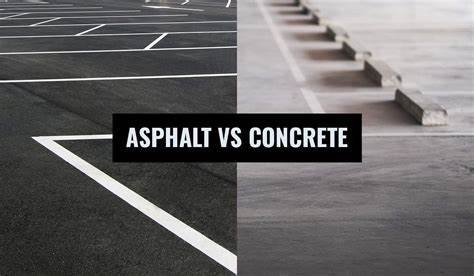Asphalt vs Concrete: Making the Right Choice for Your Oklahoma Project

When it comes to paving projects in Oklahoma, the choice between asphalt and concrete is crucial. Both materials have their strengths and weaknesses, and the right choice depends on various factors including climate, budget, and intended use. This comprehensive guide will help you make an informed decision for your next construction project in the Sooner State.
Climate Considerations in Oklahoma
Oklahoma's climate, characterized by hot summers and cold winters, plays a significant role in material selection. Asphalt tends to soften in extreme heat, which can lead to rutting, while concrete may crack due to freeze-thaw cycles. However, both materials can be engineered to withstand Oklahoma's weather when properly installed and maintained.
Initial Costs and Long-Term Value
Asphalt typically has a lower initial cost compared to concrete, making it an attractive option for budget-conscious projects. However, concrete generally lasts longer and requires less frequent maintenance, potentially offering better long-term value. Consider your project's lifespan and available budget when making your decision.
Maintenance Requirements
Asphalt requires more frequent maintenance, including seal coating every few years to prevent oxidation and cracking. Concrete, while more durable, may need occasional joint sealing and crack repair. Both materials may require periodic cleaning to maintain appearance and functionality.
Installation Time and Traffic Disruption
Asphalt installations are generally quicker and can be opened to traffic sooner than concrete. This can be a crucial factor for projects where minimizing downtime is essential, such as busy commercial areas or high-traffic roads in Oklahoma cities.
Aesthetic Options and Customization
Concrete offers more design flexibility with options for coloring, stamping, and texturing. This makes it popular for decorative applications in residential and commercial settings. Asphalt, while primarily limited to its traditional black appearance, can be colored or stamped, though these options are less common and may affect durability.
Environmental Considerations
Both materials have environmental impacts to consider. Asphalt is recyclable and can be reused in future projects, reducing waste. Concrete, while not as easily recyclable, has a longer lifespan and can contribute to reducing the urban heat island effect due to its lighter color, which may be beneficial in Oklahoma's warmer regions.
Specific Applications
- For high-traffic roads and highways in Oklahoma, asphalt is often preferred due to its smoother ride and ease of repair.
- For parking lots, both materials are suitable, with the choice often coming down to budget and aesthetic preferences.
- For residential driveways in Oklahoma, concrete is popular due to its durability and design options, but asphalt can be a cost-effective alternative.
Conclusion
The choice between asphalt and concrete for your Oklahoma project depends on a balance of factors including climate, budget, maintenance capabilities, aesthetic preferences, and specific use requirements. Both materials have their place in Oklahoma's construction landscape, and the right choice will ensure a durable, functional, and cost-effective solution for your paving needs.
Need Expert Advice?
At Alexis Bolt Construction, we specialize in both asphalt and concrete installations across Oklahoma. Our team of experts can provide personalized recommendations based on your specific project requirements. Contact us today for a consultation and let us help you make the best choice for your paving project.